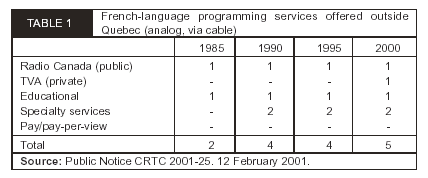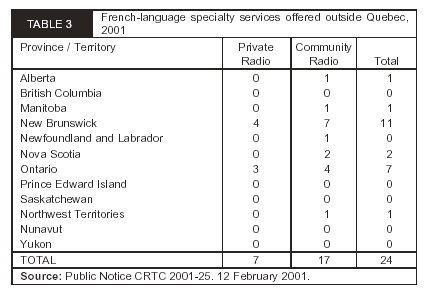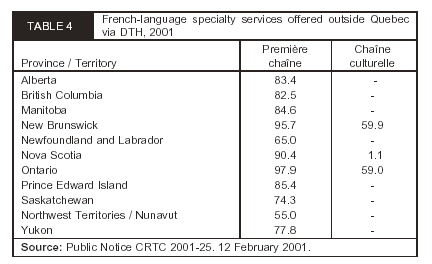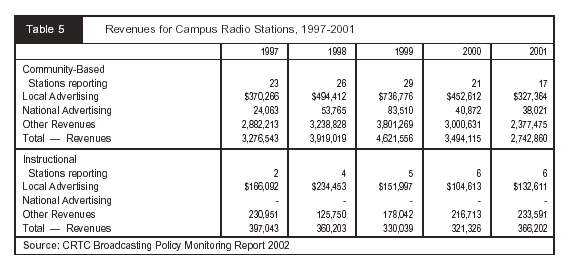HERI Committee Report
If you have any questions or comments regarding the accessibility of this publication, please contact us at accessible@parl.gc.ca.
|
Appendix 11 Ethnic Services Television While the CRTC acknowledges the contributions made by community cable channels to ethnic programming, it also licences ethnic television stations as separate entities.1 The CRTC's 1999 ethnic broadcasting policy provides the framework for such services.2 It states: An ethnic program is one, in any language, that is specifically directed to any culturally or racially distinct group other than one that is Aboriginal Canadian or from France or the British Isles. Furthermore: Ethnic programming may be in English, French, a third-language or a combination of languages. It also includes cross-cultural programming provided, once again, that it is specifically directed to any culturally or racially distinct group other than one that is Aboriginal Canadian or from France or the British Isles. As noted in Chapter 4, there are at present four over-the-air multilingual ethnic television stations, operating from Toronto (OMNI 1 and OMNI 2), Montreal (CJNT) and Vancouver (MVBC). There are also five analog Canadian ethnic specialty services (available on a discretionary basis): Fairchild TV, Talentvision, SATV, Odyssey and Telelatino. Since 2000, the Commission authorized more than 50 ethnic Category 2 (i.e., digital) specialty and pay services in a variety of languages.3 Of these, ten (8 specialty and 2 pay) have been launched.4 Radio The CRTC's 1999 ethnic broadcasting policy applies to radio in much the same way it applies to television. For radio, the Commission notes that: "the spoken work component of the program determines the ethnic group being served."5 At present, there are 13 licenced ethnic radio stations in Canada and a further 19 ethnic radio stations carried by 12 licenced FM stations as Subsidiary Communications Multiplex Operations (SCMO).6 These stations broadcast programming in dozens of languages. Vancouver's three ethnic stations, for example, air programming in over 40 languages and average (when combined) more than 400 hours of ethnic-language programming each week.7 Television To encourage off-air community television operations in areas too small to support a full range of over-the-air or cable services, the CRTC decided in 1987 to grant licences to low-power television stations for operation in remote or underserved communities.8 The Commission expects low-power television services to: ... develop community-oriented programming that contributes to the diversity of television services within the community. The Commission also expects operators of such services to serve all members of the community by offering some programs which appeal to everyone, as well as programs which deal with matters of interest to specific groups within the community. In 2000, there were 20 low-power television services across Canada. Many of these stations rebroadcast the CBC's Northern Television Service and provide a limited amount (typically 2 hours a day) of local programming such as local events, sports, council meetings, church services, bingo and community announcements.9 The CRTC licences a number of low-power radio stations as it believes that such: ... undertakings make a contribution to the goals set out in the Broadcasting Act and may attract new entrants into the Canadian broadcasting system. Such services are particularly well-suited to provide local community-based programming.10 The Commission's 2002 policy for the allocation of licences uses the following categories: Priority A services: 1. Originating conventional not-for-profit radio services (e.g. community, campus and Native); 2. Originating conventional for-profit radio services (private commercial broadcasters including ethnic); 3. Rebroadcasting transmitters of local stations rebroadcasting within the station's contour; 4. Rebroadcasting transmitters of distant signals (the CBC will have priority within this sub-group of Priority A services). Priority B services: 1. Not-for-profit public information services (e.g. traffic or weather information services); 2. Commercial announcement services.11 Some low power radio stations are Type A or Type B community stations; others are religious, native, campus, tourist or travel. Table 1 profiles English and French language low power stations in Canada. Francophone Minority Communities Television In April 2000, the federal Cabinet issued an Order-in-Council which ordered the CRTC to review French-language broadcasting in minority environments. This review (released in early 2001) provides some information on how Canada's French-language minority communities are faring in today's changing communications environment. Table 1 shows the overall growth in available French-language television services offered to cable subscribers living outside Quebec since 1985.
It is important to note that about 80% of all Canadian households outside Quebec subscribe to at least basic cable. This table reveals that French-language television channels available to Canadian cable subscribers living outside Quebec more than doubled (from two to five) between 1985 and 2000.12 Table 2 shows the situation for direct-to-home satellite subscribers, the fastest growing broadcast distribution platform in Canada today.13 These data show that DTH subscribers enjoy even greater French-language choice than cable users.
All told, the CRTC's review exhibits some optimism and moderate concern for the delivery of French-language television services to francophone minority communities outside Quebec. For example, with regard to analog service provision, it notes that it will "not permit any reduction in the number of French-language services distributed on analog channels in Anglophone markets." Concerning public television, it states that: "all cable systems will be required to distribute at least one CBC signal in each official language." And, with respect to the specialty service, Télé des Arts, it stresses that it must "be made available free of charge to cable distributors who distribute the service on an analogue basis in Anglophone markets." As for the overall reflection of Francophone minority communities in broadcasting services, the Commission believes that: To adequately meet the needs of French linguistic minority communities and better reflect their realities, a number of elements must come together. These include access to more French-language broadcasting services, increased production of quality programming and better reflection in the programs aired by conventional television broadcasters — public and private, educational, specialty and community services — most of which serve the large Francophone market of Quebec. Radio As noted above, the CRTC assessed the availability of French-language broadcasting services for Francophone minority communities outside Quebec in 2001. Table 3 shows the situation for private and community-based French-language radio. This table reveals that very few regions outside Quebec have French-language private radio services, while a slightly greater number are served by community radio. Overall, four provinces (British Columbia, Newfoundland and Labrador, Prince Edward Island, Saskatchewan) and two territories (Nunavut, Yukon) have neither private nor community radio outlets.
The availability of CBC French radio services outside Quebec is presented in Table 4. As can be seen, the CBC's Première chaîne exceeds 80% availability in most regions outside Quebec, whereas the Chaîne culturelle is virutally inaccessible, except in Ontario and New Brunswick
In its assessment of the situation facing French-language radio outside Quebec, the CRTC notes that part of the problem has to do with the allocation and assignment of frequencies, particularly FM frequencies, which are becoming increasingly scarce. For this reason, it has called on Industry Canada to "examine the measures ... to increase the number of over-the-air analog and digital radio frequencies available within spectrum." It also believes that in "the current context, the CRTC should continue to ensure that all new frequency allocations constitute the best possible use of those frequencies, in the public interest." Campus radio is another category of community radio licenced by the CRTC. These stations are generally associated with post-secondary educational institutions and are expected to be not-for-profit. Volunteers who are either students or members of the community produce most programming. The Commission's 2000 policy for campus radio stresses that the: ... primary objective for the campus radio sector is that it provide programming differing in style and substance from that provided by other elements of the broadcasting system, particularly commercial stations and the Canadian Broadcasting Corporation (CBC). The Commission considers that campus stations should add diversity to the broadcasting system by providing alternative programming in both music and spoken word.14 The CRTC views campus radio as being complimentary to commercial and community radio stations operating in the same market. Accordingly, its describes campus radio in the following way: A campus radio station is a station owned or controlled by a not-for-profit organization associated with a post-secondary educational institution. There are two types of campus stations: Community-based campus: This is a campus station with programming produced primarily by volunteers who are either students or members of the community at large. The training of professional broadcasters is not the station's primary objective. Instructional: This is a campus station that has the training of professional broadcasters as its primary objective.15 Campus stations are allowed to broadcast four minutes of advertising per hour, The Commission believes that "this measure will provide campus stations with additional flexibility with respect to their sources of revenue" and is "the best way to ensure that campus stations provide programming that is different in style and substance from that provided by other stations."16 In 2002 there were 47 campus stations licenced across Canada of which 38 were community-based and nine were instructional. The major revenue sources for these stations came from the educational institution with which they were associated, advertising, grants, the local community and fund-raising. Table 5 shows the revenues for those campus stations that filed returns with the CRTC between 1996 and 2000.
This table reveals that campus radio stations are much less dependent upon advertising than their community radio counterparts, with the majority of revenues coming from other sources, primarily the educational institution with which each campus station is affiliated. Endnotes
|




